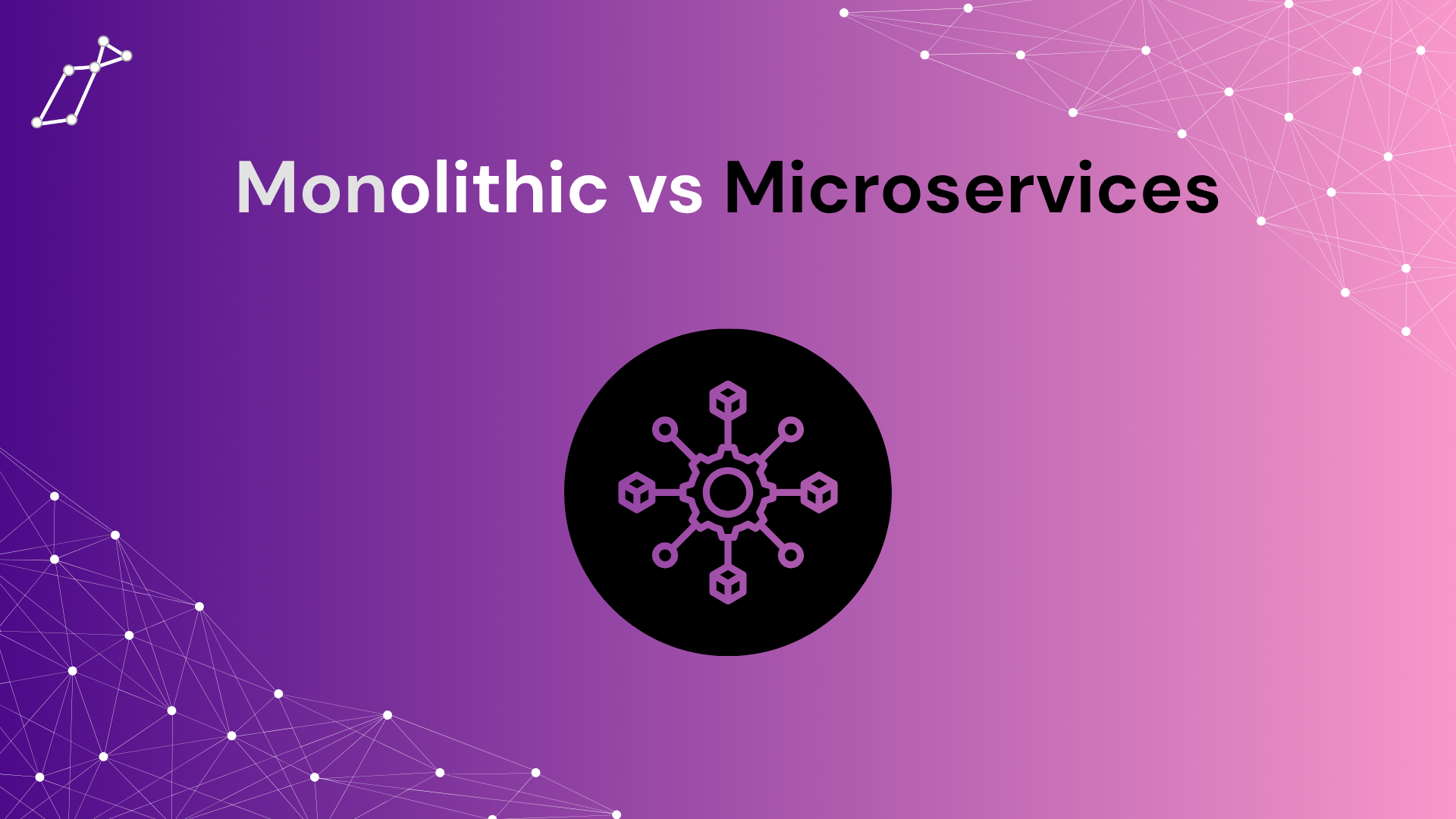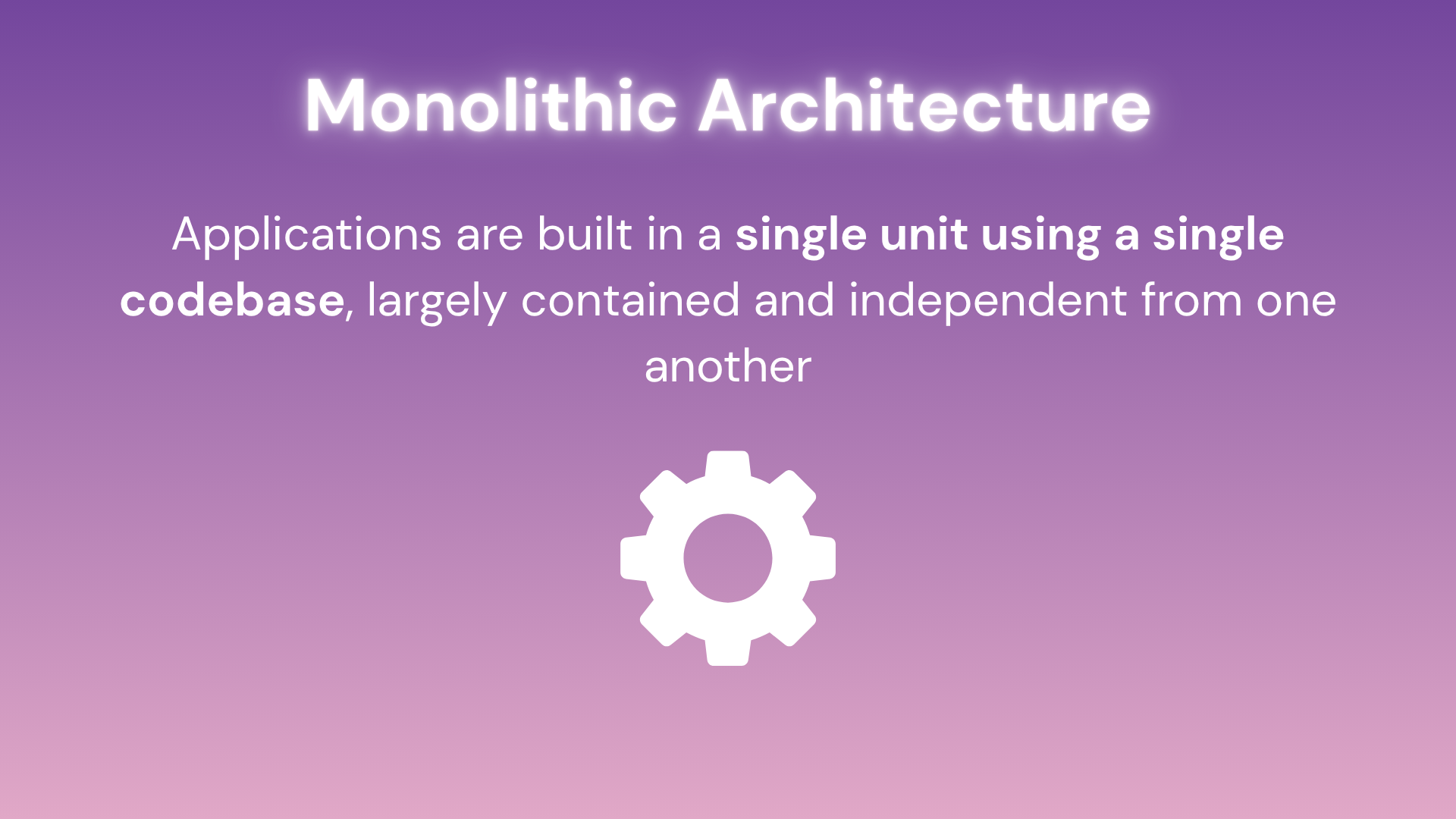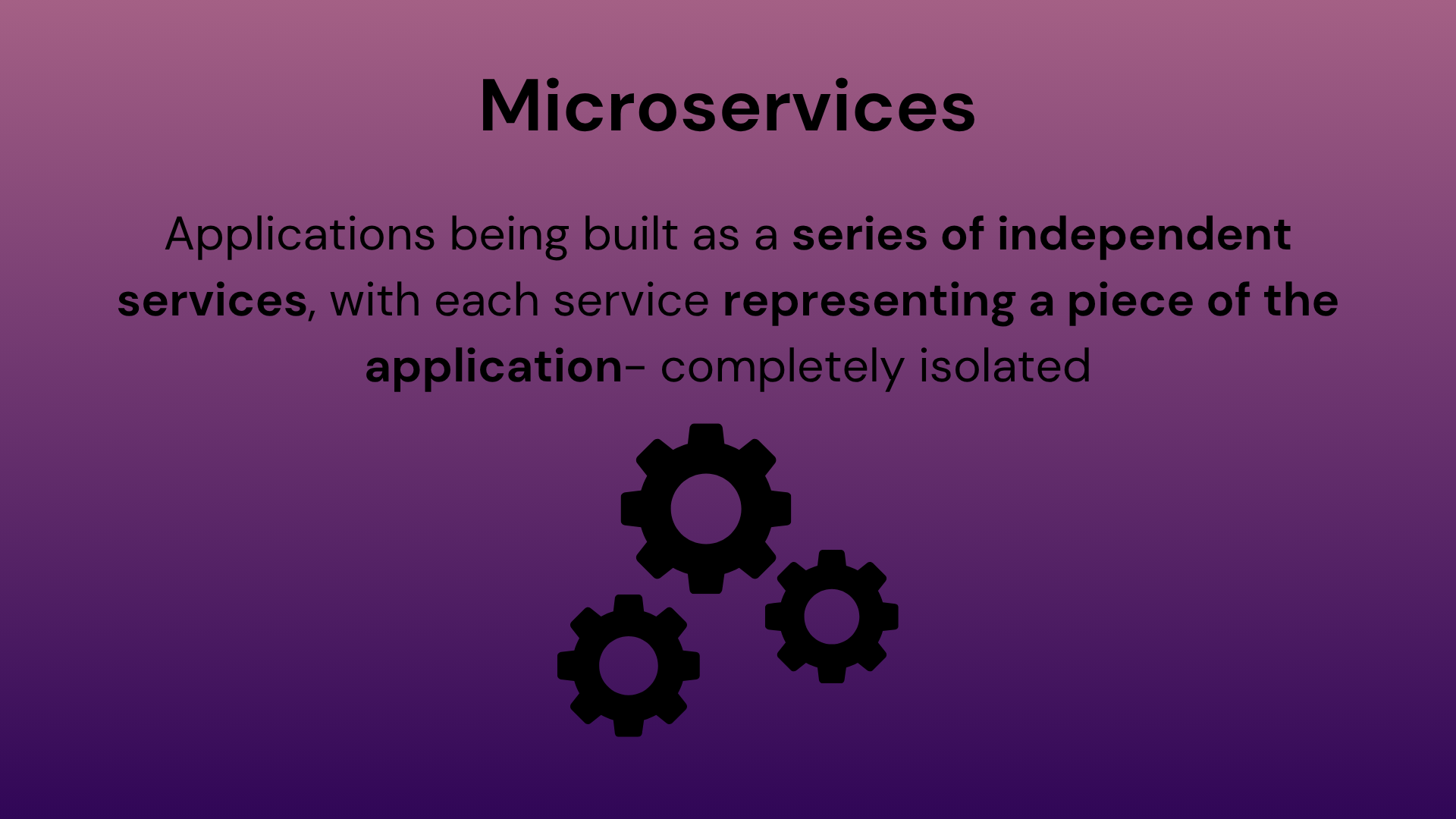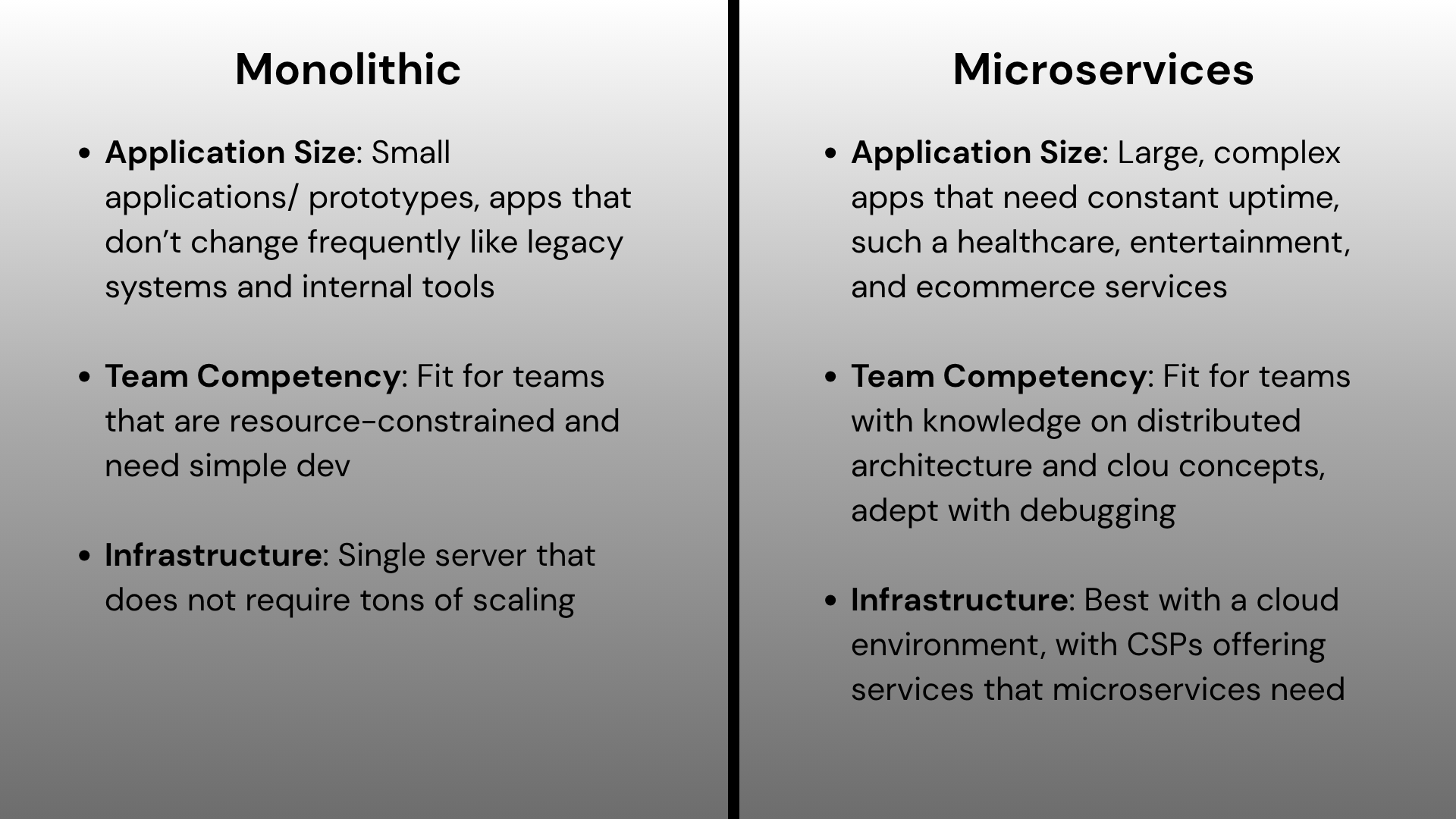Monolithic vs Microservices Architecture: Differences and How to Choose



Monolithic vs Microservices Architecture: What’s the Difference?
The monolithic vs microservices debate is one that pits tradition versus modernity. Monolithic architecture reflects a traditional software model, building applications as a single unit. Microservices is a modern software approach, building applications as a series of independent units that are isolated and deployable separately.
Although microservices architecture is the latest approach in software, monolithic architectures are not completely obsolete. Each architecture has their specific use cases, excelling in areas and builds that the other option might fail at. Your choice of hosting architecture depends largely on unique factors such as your application, team size, infrastructure, and much more.
When it comes to monolithic vs microservices architecture, it is important to consider all aspects of both options. From operations, pros, cons, and use cases, both architectures offer powerful capabilities for users if approached correctly. That being said, what are some differences to consider?
What is Monolithic Architecture?
As mentioned, a monolithic architecture sees applications being built within a single unit, with applications being contained and independent from each other as a whole. Applications built within monolithic architecture are constructed within a single code base and are part of a large computing network.
One codebase in the application carries out all important business functions and is managed through a central location. Because monolithic applications are built within a single code base, monolithic architecture is therefore suitable for early stage applications that do not require too much scale or complexity.

Where monolithic architecture may run into hurdles is on the topic of deploying changes and enabling scale; depending on the application, operating on a monolithic architecture may actually prevent extreme growth and can cause operational problems with unexpected workloads.
Benefits of Monolithic Architecture
Monolithic applications being confined into a single unit and codebase has its perks. Generally speaking, monolithic architectures are geared towards fast development, allowing small and resource-limited teams to ship MVPs and applications at a moment’s notice. Benefits of monolithic architectures include:
- Simplified Development and Testing: Building within a single codebase enables teams to develop without complexity, allowing for faster testing as well.
- Streamlined Deployment: Monolithic applications are built and deployed within a single file, streamlining the deployment process in comparison to shipping out multiple parts.
- Enhanced Security: With applications being isolated from one another, monolithic architecture encourages stronger security through operation in a closed network.
- Easy Debugging: Issues are easier to identify and requests are easier to follow within a single codebase.
Organizations looking for stress-free deployment will find monolithic architecture particularly enjoyable, with software debugging and maintenance processes also being a breeze.
Cons of Monolithic Architecture
While the nature of monolithic architectures enables fast development and deployment, this build style also leaves a lot to be desired. Cons of monolithic architecture include:
- Decreased Scalability: Scaling within a monolithic architecture requires scaling an entire application, which can be strenuous and may even require more servers to be onboarded.
- Lack of Flexibility: Monoliths are often contained by the tech already used inside, with adopting new services and tech languages often requiring a complete tech overhaul.
- Code Changes: Any small changes within an application requires a new deployment, especially with bug fixes and updates.
- Reliability: Errors that affect one aspect of an application may affect the entire monolithic application, potentially leading to prolonged downtime.
Because of these drawbacks, the monolithic approach is not suitable for applications that require high uptime and availability, nor is it suitable for services that require rapid scaling in time of high traffic.
What are Microservices?
On the other hand of the monolithic approach is the microservices architecture. Microservices sees applications being built as a series of independent services, hence the name “microservices”. Each service represents a piece of the application, with each service being independent and isolated despite their role. Much like different teams of an organization having their own goals but working together to achieve an organization-wide mission, microservices have their own logic, database, and specific goal.
Unlike monolithic applications that are built within a single codebase, microservice processes such as updating, testing, deployment, and scaling are all conducted independently, allowing services to operate and optimize independently. Because of this, individual codebases enable teams to utilize different development tools and languages.

Microservices are not necessarily an upgrade from monolithic apps, but more so an alternative development path that makes development complexities more visible, development processes more independent, and development scaling more approachable.
Benefits of Microservices
Splitting the development and operations of application into microservices provides unparalleled benefits, with some of the most prominent including scale, agility, and flexibility. The benefits of microservices include:
- Enhanced Scalability: Through microservices, organizations are able to scale independent parts when necessary instead of the entire application, letting applications meet demands at a moment’s notice.
- Technical Adoption: Teams operating microservices can adjust their tech stack and languages as necessary, optimizing development approaches with each new service.
- Increased Agility: Microservices promote agility, with each team being responsible for further developing their core service and innovating based on organizational demand
- Automated CI/CD: Microservices enable organizations to automate their CI/CD, with updates and bug fixes being deployed faster. This also encourages stronger reliability, with app changes being deployed on a single service instead of potentially threatening an entire application.
- Higher Fault Tolerance: With multiple services working, one failed service will not affect the operations and wellbeing of other applications.
Microservices are best suited for applications with high velocity, scaling at a moment’s notice while pushing for increased technical adoption. Applications that require high availability and uptime will enjoy the benefits of microservices the most.
Cons of Microservices
Despite independent services and high scalability, the existence of microservices threatens the idea of standardization and service ownership, amongst other organizational traits. Cons of microservices and other drawbacks include:
- Development Complexity: Depending on team competence, having more services to develop may be a drawback, increasing management complexity in the process.
- Complex Debugging: Unlike monolithic architectures where debugging is convenient in a single codebase, microservice debugging requires going through each service, made even more complex with different tooling and coding languages.
- Increased Overhead: Overhead can refer to many things in this case: increased infrastructure costs, more communication and collaboration requirements, and sometimes more hiring are involved with microservices.
- Lack of Standardization: Each service can have their own set of coding languages, logging, and monitoring, making development as an outsider a pain.
- Lack of Clear Ownership: Despite individual service teams, each service still represents a part of the whole application. Service ownership can be blurred when combining services and collaborating on services.
For these reasons, microservices are not suited for simple applications or small teams, veering towards applications that need around the clock support and high uptime.
When to Use Monolithic Architecture vs Microservices
With some of the pros and cons of each architecture in mind, you’re probably wondering when to use monolithic vs microservices. To sum up each architecture:
- Monolithic architecture builds applications within a single unit, prioritizing simplicity above all else. With a unified code base, monolithic applications have streamlined deployment and development, but lack flexibility and scalability.
- Microservices are independent services, with each service representing a portion of an application. This architecture prioritizes scalability, agility, and flexibility, though at the expense of complicated debugging and ownership.
But when do you use each architecture? With so many factors and differences between organizations and applications, certainly it would be hard to determine the right architecture, right? AWS has defined architecture use based on 3 application and organizational characteristics:
Application Size
With a single unified codebase, single large network, and unified build philosophy, the monolithic architecture is best suited for simple applications and prototypes, specifically MVPs. These applications would thrive under regular use and without frequent changes. Examples of applications that fit under this criteria include internal business tools, legacy systems, content management systems, and other operating systems. Organizations like startups with early stage products will benefit the most from the monolithic architecture.
On the other hand, microservices better serve complex systems, with the ability to grow with application demand being integral to operational success. With the ability to easily onboard new services and languages while promoting quick changes through independent codebases, microservices enable complex apps with a need for high availability to thrive. Applications with high traffic such as ecommerce and entertainment platforms, and applications that require high availability, such as healthcare platforms and billing systems, will particularly benefit from microservices.
Team Competency
Monolithic architectures promote simplicity in development, prioritizing faster development with even faster deployment. This infrastructure type does not require a ton of resources, nor does it encourage an ever-changing tech stack with new coding languages. For this reason, monolithic architectures are suited for teams with low resource allocations for the time being. This also extends to teams that may be novice within development, but are competent enough to hit the ground running. 1-man development teams may find the simple approach towards development beneficial, especially compared to the complexity of microservices.
Contrasting immensely to the simplicity of monolithic architectures, microservices are extremely complex, prioritizing scalability and flexibility above all. Users of this architecture should be well-versed in concepts like containerization, cloud architecture, and APIs. When working with Kubernetes, APIs in particular are important to create communication networks between services. Debugging may also be a struggle for smaller, more resource-constrained teams. Because of this, teams working with microservices should be experienced with distributed architecture and competent enough to quickly identify bugs.
Infrastructure
With a unified philosophy, monolithic architectures run on single servers, which may or may not be a bad thing. Depending on your uses, a single server can be lightweight and not as costly. However, the threat of security breaches is stronger with single servers.
Microservices benefit the most from a cloud environment, with cloud providers offering the services that microservices need to excel. These environments also support the rapid development and deployment that is synonymous with microservices, as well as support the different languages and tech stacks teams need to thrive.

Architecture choices largely depend on the nature of your application, with demands such as high availability, security, and uptime significantly veering the decision between monolithic vs microservices.
Microservices vs Monolithic Architecture with Lyrid
The monolithic architecture vs microservices debate pits each option against each other, however there is not a clear winner or loser. On one end, monolithic architecture provides a unified approach towards software development, creating a single codebase and server where development and deployment are streamlined at the expense of scalability and flexibility. On the other hand, microservices prioritize scaling and flexibility, splitting an application into several services that can be quite confusing down the line.
For startups and organizations looking to get to the next level, microservices are certainly the go-to architecture option. We made the case for it above, but microservices are scalable and grow as you do. The problem is, many companies find trouble trying to migrate from monolithic architectures to microservices- there’s so much that can go wrong!
Lyrid is here to help.
Lyrid aids in migration from monolithic architectures to microservices, containerizing users' applications and making them extremely flexible and ready for deployment anywhere. Users can access Lyrid’s Kubernetes tooling to orchestrate their new microservices, allowing for automated scaling, automated health checks, automated failovers, and so much more! With the help of Lyrid, Aido Health has transitioned from monolithic infrastructure to microservices and seen considerable improvement in application speed, spending, and revenue potential!
Looking to try out microservices for yourself? Or are you currently operating in monolithic infrastructure but need to switch over? Book a call with one of our product specialists for more information on our migration process!











